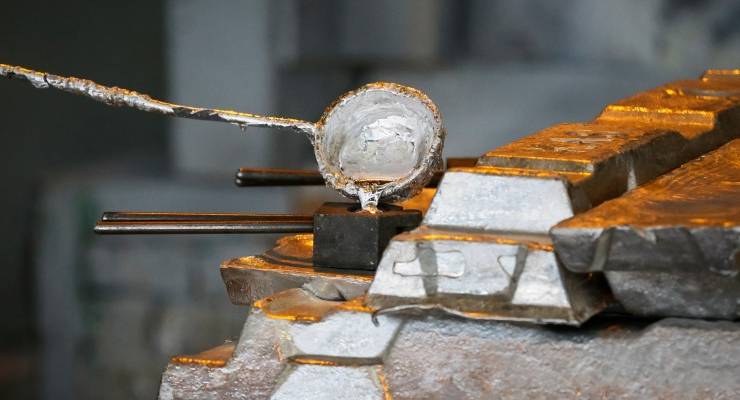
Everyone understands the link between commodity prices and geopolitics, even if they don’t know it. When things go south in Saudi Arabia, Iran or Russia, prices at the pump go up. That’s because of the outsized role those countries play in the oil market.
But there are other commodity markets that people only pay attention to when it affects their wallets in surprising fashion. This summer, for instance, coffee prices spiked due to climate change and poor Arabica harvests in big coffee-producing regions.
West African countries have whipsawed the price of cacao, making policy changes that protect the livelihood of small farmers, which affects the price of chocolate. What you pay for your smartphone or electric car depends in part on what happens in the Democratic Republic of the Congo, which overwhelmingly dominates the global production of cobalt.
What happened this week was a huge spike in the price of aluminium, which goes into everything from cars and trucks to phones and beverage cans. The metal touched $3000 a tonne — the highest it’s been since the 2008 global financial crisis — before settling down a wee bit after a couple days. But it’s still almost 70% more expensive than this time last year.
Why has the cost soared?
Because of Guinea, a tiny country in West Africa. Earlier this month, a military junta ousted Guinean president Alpha Condé in a coup driven by frustration over a lack of social and economic reform during his tenure. (Ramming through a referendum to ignore term limits and extend his time in office didn’t win Condé any friends either.)
Guinea is one of the major producers of bauxite, the mineral that is the raw ingredient for the production of aluminium. With a country so dependent on mining producing a commodity the world is so reliant on, a military coup naturally introduced uncertainty into the market — and uncertainty often means volatility. Even though Guinea’s mines are making an effort to keep operations normal and production steady, prices can still rise because commodities are traded speculatively. This means traders are nervous about what could happen with this batch of colonels, or even the next government, whenever it’s formed.
Guinea’s travails have indirect effects. Any blip in the bauxite supply chain has potential to wreak havoc later on. This is especially true seeing that China, which turns much of Guinea’s rocks into shiny metal, has become a net importer of aluminium recently, so it doesn’t necessarily have the domestic back stock to keep up with industry demand.
Back up: where does aluminium come from?
Long story short, it comes from an ore called bauxite. According to the US Geological Survey, bauxite is the “only raw material used in the production of alumina on a commercial scale”. In other words, if the world wants aluminium, the world needs bauxite. The process that turns bauxite into aluminium is called smelting, and it is fairly resource- as well as energy- and emissions-intensive. It’s a messy business.
While Australia was the world’s largest producer of bauxite last year, digging up 110 million tonnes, Guinea produced 82 million tonnes, or 22% of the world’s supply. For a country of just 13.6 million people, that is no small feat. More importantly, perhaps, it also has the world’s largest reserves of bauxite, with 7.4 billion tonnes. Guinea may not be to aluminium what the DRC is to cobalt, but it’s almost there.
What does this mean for the prices of goods that use aluminium?
Well it’s not good. Aluminium is everywhere these days. It’s used heavily in automobile production: Ford’s F-150 pick-up, the best-selling vehicle in the US, uses loads of it, which unfortunately got pricier thanks to former US president Donald Trump’s tariffs on imported aluminium. It’s in mobile phones. It’s in cans. The US uses it extensively in defence production. And the post-pandemic “greening” of the economy has led to increased aluminium demand due to its prevalence in electric car production and solar panels, as NPR’s Marketplace pointed out.
Increased demand, combined with continued political uncertainty in Guinea, could keep aluminim prices sky high. If that happens, the prices of consumer goods will inevitably inch upward. The more volatile Guinea’s political situation is, the bigger the effect.
How long will this last?
It depends on how long political instability in the country persists. Lately, consultations have begun to shift from military rule to a transitional government. But it could take weeks — or a whole lot longer — for a final decision to be made.
In the meantime, the leader of the coup, Colonel Mamady Doumbouya, rushed to assure big mining companies he wouldn’t do anything to disrupt operations, which might take some of the froth out of the market.
Bauxite is Guinea’s golden goose, so it’s not likely the new junta will do anything to jeopardise exports in the short term. But if political instability continues — or if the government decides to take a bigger bite of mining revenues, potentially even leading to closures — supply problems could creep into an already jittery market. And if you drive, talk, or eat leftovers, that is not what you want to hear.









This article is a reprint from a US publication, shown by the casual mention that actually, Australia is the world’s largest bauxite producer. In light of this, an Australian angle would be useful.
I thought the same as I was reading this. Not only do we produce shiploads of bauxite, but we have many (I forget how many) alumina refineries and smelters. Why couldn’t Crikey put a few comments on the Australian impacts of a rise in the bauxite price.
Lazy journalism……
Aluminium smelting need not be a heavy emitter of fossil carbon. Aluminium ore is an oxide that dissolves in the fluoride melt. When electrolysed, the aluminium metal appears at the cathode. If the electricity is not fossil based, aluminium smelting does not produce fossil emissions at that point. Current practice is to use a carbon anode, so the oxygen comes off as concentrated CO2. That would make it easier to recycle the carbon, however it would be better if the industry moved to inert metal anodes and avoid carbon emissions entirely.
Iron can be smelted in a chloride melt analogous to the smelting of aluminium in a fluoride melt. There are other electrolytic methods to reduce iron from its ore, but in all cases it is currently cheaper to emit CO2 from blast furnaces based on coal or gas.
The bauxite must first be converted to alumina ( Al2O3) before smelting.
Peter – yes, bauxite as mined contains silicates, silica and iron oxides etc. The Bayer process leaches out the alumina and some of the silica, which is precipitated out separately from the alumina. The alumina is calcined before being used as the raw material for the electrolysis.
So are we not recycling aluminium cans etc. What is happening to this recycling?
We do better than I had thought before a simple search.
5th in the world according to a QLD government website at 70% of our cans.
This is from memory, it’s been a couple of decades but I had a sister plant relationship with a recycling plant in the UK.
A typical can uses 3 different alloys of aluminium (body, closure/top and tab).
Unfortunately, the recycled metal from these UBCs (used beverage containers) does not make all of the grades suitable for making more cans. I recall that the closures need fresh material.
That said recycling is a dirty process involving salt baths, potential stack emissions and the use of fluxes. Not something popular with neighbours.
A useful contribution other than it being from a US perspective. As others noted, Australia a huge producer and unusually a refiner as well.
“ or if the government decides to take a bigger bite of mining revenues, potentially even leading to closures.”
But this makes no sense to me. If the price per tonne has gone up 70% and they were already profiting from it, then that 70% is all cream (recognising that it’s not that simple as ore has to be refined).
If an ore price is going gangbusters at least half of the extras should go to government (the State, the common wealth)
The States royalties systems here seem to take no account of this, therefore we should have a resource rent super profits tax.
Oh yeah, tried that, didn’t go well did it. Somehow Norway managed.
Aluminium is often called “congealed electricity” and it’s unforgiving of interruptions. So countries that are trying to minimise fossil fuel usage are going to be reluctant to subsidize aluminium smelters.